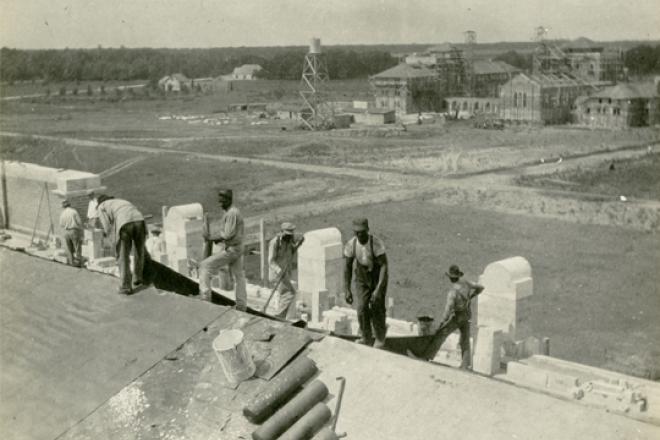When your boot is sucked off your foot by the snarl of reeds and charcoal-colored mud at the edge of the water, you try not to think of the alligators. You know that your focus should be on stuffing your soaked white sweat sock back into the black hole of the boot. Still, you first scan the weeds for movement before jerking your boot out of the mud and scaling the embankment that overlooks the water.
This is, of course, assuming that the platter-sized bleached-bone alligator skull on display at Sheldon Lake State Park’s Pond Center didn’t dissuade you from wandering alone into the park’s restored wetlands to examine how the soil changes. Keep in mind --- you’ve been told that the soil’s what matters.
Freshwater coastal prairie wetlands work because of two major soil types: light, well-draining alluvial soil at higher elevations and clay-bottomed hydric soil in the lower basins. In formations known as “prairie pothole pimple-mound complexes,” these soils and changes in topography account for the hydrology of the wetlands and help support a staggering variety of flora and fauna. “And they're only a couple feet away from each other,” said Marissa Sipocz, the wetland program manager for the Texas Coastal Watershed Program who leads the Sheldon Lake State Park restoration efforts. “That's the beautiful part of the whole matrix. That's why, from an ecological point of view, you have to look at it as a whole.”
The Sheldon restoration involves a collaboration between the Texas Parks and Wildlife Department (TPWD), Texas A&M’s AgriLife Extension Service, and Texas Sea Grant. Ongoing since 2003, it is split into four phases that will ultimately total more than 180 acres of restoration. Phase 1 is complete and thriving --- the local plants that were transplanted by scores of volunteers have propagated, and the local wildlife is fully supported. As soon as you step into Phase 1, you are buried in the hum of insect activity and the smell of the dense native grasses. As you move through, you’re startled by the sudden explosion of feathers as a bird that you didn’t know was there takes off from beneath your feet and disappears over the tops of the gray grass stalks.
Phases 2 and 3 are technically complete, according to Sipocz, but her team of staff and volunteers are continuing weekly maintenance in order to compensate for the multi-year drought conditions that the park has faced. Phase 4 is expected to begin next spring and take approximately 2 years for planting to be completed.
These types of wetlands are one of the most critical ecologies of the Houston-Galveston area, serving not only as habitat for wildlife but also as natural flood control and filtration mechanisms. This is partly why wetlands preservation, mitigation, and restoration are so important, but those closest to the issue acknowledge room for improvement in many of these initiatives since the science of wetlands is extremely complex.
“Typically, in this region you dig a hole in the ground, fill it with water, throw some plants in there, and --- voilà --- you have a wetland. The problem is that doesn't always work,” said Sipocz. Among the primary reasons it doesn’t work, she explained, is that the plant selection is not ideal or the soil chemistry is not quite right. This leads to what makes the Sheldon restoration efforts especially unique. After years of human development, the ideal soils were still in place, just a foot or so beneath the topsoil, buried alive and waiting to be rediscovered.
The park area was first developed in the 1940s as a reservoir to provide water for war industries, and roughly 10 years later it become a wildlife management area after being acquired by the TPWD. It was finally designated a state park in 1984. However, throughout much of this time, the land was also used for agriculture. Its wetlands were leveled for row crop farming --- the pimple mounds were flattened, the potholes filled in. The original soils, with ideal hydrology and pH to support a thriving wetland habitat, were covered up.
Recognizing the history of the park, Andy Sipocz, natural resource coordinator with the parks department, devised a method to re-create the site's predevelopment conditions. This would not only better the chances of a successful wetland restoration, but it would also allow park visitors to experience the land in its original state. His technique was simple in its concept and painstaking in its application. He superimposed aerial photos and topographical maps --- some from as early as the 1920s --- over modern maps and photographs of existing features of the landscape. This enabled him to identify the locations of original wetland signatures in place before the land was developed. His conclusions about the predevelopment landscape were verified when soil cores taken on site confirmed that he had accurately identified the previously high- and low-lying areas.
While arduous at first, software advances mean that this historical matching process now takes much less time, and the energy of the restoration team can be directed toward organizing volunteers and working on site during their "Wetland Wednesday" planting events. Once the original topography has been recreated and the underlying soil revealed, the team introduces native vegetation collected from nearby areas or grown on site. These restoration efforts have transformed the story of Sheldon Lake State Park as much as its landscape. During the last century, humans employed science and technology to alter the area for their needs, but so far the story of this century is that of different technologies and a shared effort to return the land to its natural state.
As the rain gradually stops in the Phase 1 wetlands, the air is thick and quiet. The sounds of birds slowly return, but not yet the same cicada buzz as before. You trudge through the matted vegetation along the edge of the basin, heavy from the mud and the rain. Spring-green stalks with bright leaves sway over the frayed tips of gray grass. Down in the water, not 30 feet away, a long knobby snout floats motionless. A tail gracefully undulates just below the surface.
By Colley Hodges
More >>>
Read articles from Cite 93, focusing on environmental issues.











